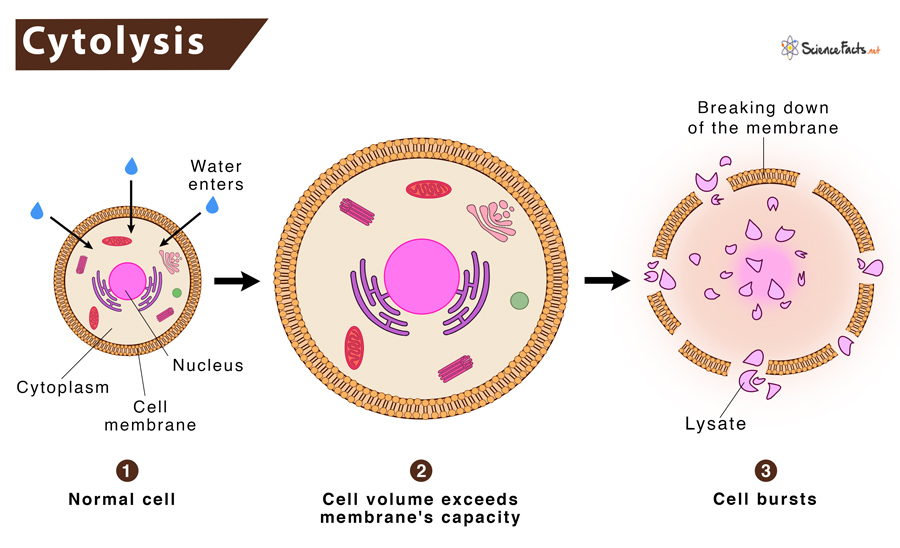Cytolysis, also known as osmotic lysis, is defined as the breakdown or destruction of cells due to excessive influx of water into the cell.
What Causes It
Types of Cytolysis
Importance
How to Prevent Cytolysis
Cells generally have a higher salt and ion concentration than their outside environment. Therefore, when placed in pure water or a hypotonic solution (with lower salt concentration), water begins flowing from the extracellular medium into the cell, crossing the plasma membrane. Here, water follows the law of osmosis. It flows from lower salt concentration to higher salt concentration or higher water potential to lower water potential across the semi-permeable plasma membrane. Due to the continuous inflow of water, the cell swells up. Further, when the cell membrane fails to hold the extra volume of water, it bursts. As a result, it releases its contents into the extracellular environment.
1) Cytolysis Due to Hypotonic Environment
If cells are placed in pure water, a massive influx of water occurs, which causes the cell to burst. A 100 ml saline solution with 0.9 grams of NaCl (sodium chloride) is isotonic because it has a similar salt concentration to the interior of a red blood cell (RBCs). Suppose RBCs are placed in a hypotonic solution, i.e., a solution containing a lower salt concentration than the cell. In that case, water will start to move inside the cell following its concentration gradient through endosmosis. As an inward movement of the water continues, the cell swells up. Consequently, it bursts when it becomes unable to hold the excess water. As a result, red blood cells undergo hemolysis when placed in distilled water.
2) Cytolysis Due to Immune System
The immune system of a living cell uses various methods to induce cytolysis both in pathogens and in infected or cancerous cells in the body. Natural Killer (NK) cells and T-cells are the most potent mediators of cytolysis in the immune system. Both the cells can either induce a cell to perform apoptosis or release proteins (perforins) that form channels on the cell membrane. Through these channels, water enters, and the cell undergoes osmotic lysis. NK cells are also responsible for the osmotic lysis or apoptosis of the tumor cells. They recognize cancerous cells and recruit other cytotoxic cells or activate an inflammatory response that helps to destroy the tumor cells. How Does Cytolysis Occur via the Complement Pathway As a cellular component of the innate immune system, NK cells can also act through the adaptive immune system by interacting with T-cells and the antibodies released from B cells. With the help of the antibody and complement system, the pathogenic cells are destroyed by forming a lesion (ring-like transmembrane structure) produced by the complement proteins on the antibody-coated cell membrane of the target cell.
3) Cytolysis Due to Pathogens
Viruses need to hijack the cellular machinery of the host to undergo metabolism and initiate reproduction. After completing multiple rounds of duplication in this manner, they adjust the cell membrane in a way that causes water influx and eventually leads to cytolysis. Many viruses preferably infect particular cancer cells by recognizing them and leave normal cells intact. These viruses then induce cytolysis of tumor cells and are thus used in cancer therapy. Plants possess a natural system of defense against cytolysis because they contain a rigid cell wall. Therefore, when placed in a hypotonic environment, water rushes into the plant cell. The vacuole takes up the excess water, thus protecting the cytoplasm from dilution. As a result, the cell wall exerts negative pressure on the cell membrane, thus preventing it from rupturing. The cell wall also generates a reverse pressure, which causes the water to leave the cell, maintaining optimal turgidity. This is how plant cells prevent themselves from cytolysis. Single-celled protists such as amoeba and paramecium contain a unique organelle called contractile vacuole that helps in preventing cytolysis. This pulsating structure undergoes repeated cycles of diastole (water entering the vacuole) and systole (water pumped out of the cell). However, the exact mechanism of these contractions is still unknown. Nevertheless, these organelles seem to be functioning even when cells are placed in a solution with a high solute concentration. Multicellular organisms such as humans and other mammals generally have an advanced mechanism to maintain isotonicity in all their cells. For example, their excretory system, composed of the functional units of nephrons in the kidney, helps in this purpose. When the kidney filters blood, it removes and expels salts, ions, waste products, ammonia, and excess water at regular intervals, thus allowing the organism to maintain homeostasis. If water intake increases, the removal of water through the excretory system also increases simultaneously under the influence of an elaborate network of hormones and other physiological responses. This process makes sure that all the body cells are primarily exposed to an isotonic extracellular fluid. The outer cellular layer of the body, i.e., the skin or lining of the digestive system, is protected from cytolysis through a hydrophobic layer made of either oils or waxes.
